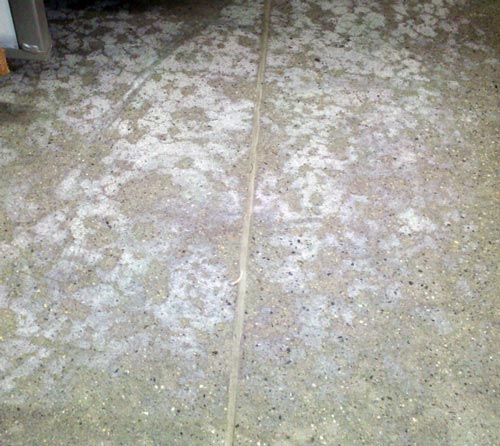All masonry and concrete materials are susceptible to secondary efflorescence, including concrete countertops. Secondary efflorescence is most often caused by moisture or water vapor migrating through a concrete slab, bringing soluble salts to the surface of the concrete. The amount and character of the deposits vary according to the nature of the soluble materials and the atmospheric conditions.
Concrete contains a variety of soluble mineral salts, both from the cement and from admixtures like calcium chloride, and even from chemicals applied to the concrete after it has hardened. It’s those salts that are the “seeds” of efflorescence. Some types of salts simply get dissolved and precipitated onto the surface, while others react with atmospheric carbon dioxide to form mineral crystals.

Efflorescence on a polished concrete big-box store floor.
While all concrete has some soluble salts in it, not all concrete will effloresce. Efflorescence will occur only if all of the following conditions exist within the concrete:
- The concrete must have soluble mineral salts within it.
- There must be moisture to dissolve the soluble salts.
- Evaporation or hydrostatic pressure must cause the mineral salt solution to move towards the concrete surface.
If any one of these conditions is eliminated, efflorescence will not occur.
Knowing that concrete contains soluble salts and that water and the movement of water through the concrete are the cause for efflorescence, then solving the efflorescence problem really boils down to controlling the movement of moisture into and out of the concrete. How this is handled varies depending upon a variety of factors, such as whether the concrete is new or old, cast on the ground or is an interior application.
Since moisture movement into, through and ultimately out of the concrete is how efflorescence forming salts move to and accumulate on the surface, the first step to controlling efflorescence started with the concrete itself, as discussed earlier in the primary efflorescence section.
Managing moisture is the next step to controlling, minimizing or even eliminating efflorescence. Dry concrete is far less likely to effloresce, so identifying moisture sources and then controlling the movement of that moisture into and out of the concrete becomes the key to shutting efflorescence down.
Consider a basic concrete floor slab cast directly on leveled, compacted ground. The concrete itself contains moisture, and if it’s made properly the concrete won’t generate primary efflorescence due to the bleedwater evaporating and leaving salts behind. But secondary efflorescence can, and probably will, occur. That’s because the ground beneath the slab is a moisture reservoir. If water was added to the sand or gravel to assist compaction, that added moisture will eventually migrate through the slab, carrying mineral salts with it and forming efflorescence. The reason vapor barriers are installed beneath concrete slabs is to isolate the concrete from the ground, which represents a large reservoir of moisture.
If the concrete floor is then sealed with an impermeable coating like a urethane or epoxy, vapor pressure or even hydrostatic pressure can cause blistering or sealer failure. Breathable coatings like acrylics allow water vapor to pass through the sealer, preventing blistering. But migrating water vapor can slowly cause salts to accumulate beneath the acrylic sealer, causing unsightly blushing or even sealer failure due to accumulated mineral deposits.
Commercial floors in elevated structures are not cast against the ground, so there’s no moisture reservoir beneath the floor to drive efflorescence. Yet these floors can effloresce too. That’s because water can enter the slab from the top during the course of finishing, acid staining and routine cleaning. Porous concrete absorbs water during mopping, and copious amounts of rinse water pump large volumes of water into the concrete. This moisture then leaches the salts out of the concrete, creating efflorescence.
Controlling secondary efflorescence is a more common problem for contractors who have “inherited” pre-existing concrete. The mix itself can’t be changed, so factors that affect water movement into and out of the concrete are where steps can be taken. Identifying and minimizing the sources of moisture are the first step. Reducing the porosity of the concrete to prevent the soluble salts from being leached out is the second step.
This second step to controlling efflorescence is to apply chemical hardeners, also known as densifiers, to existing concrete. These make the matrix less porous by generating calcium silicate hydrates that plug the pores and clog the capillaries. Done properly, they offer a threefold benefit. Reduced porosity is the first. The second is that silicate hardeners consume free lime in the concrete. Thirdly, the silicate gel binds other soluble salts, making them difficult to leach out.
While chemical hardeners seem like the ideal solution, not all hardeners are effective. In fact, using the wrong type can actually cause efflorescence. Explaining this involves a little chemistry, so bear with me.
Three common forms of chemical hardeners are sodium silicate, potassium silicate and lithium silicate. Lithium silicate hardeners are the most effective and least likely to effloresce due to a combination of factors. Lithium ions are smaller, and compared to sodium or potassium silicates, there are fewer lithium ions for each silicate molecule. It’s the silicate portion that actually does the work, so in effect lithium silicates are more concentrated. Once the silicate molecule reacts with the available calcium or free lime in the concrete, the sodium and potassium ions are freed and become soluble. In contrast, lithium ions are not freed. Free ions can react with other substances in the concrete to form salts. These salts can then leach out and form efflorescence.
Finally, high concentrations of carbon dioxide (CO2) can cause or accelerate efflorescence. Concrete located in areas with gas, wood or oil-fired heaters will develop efflorescence faster than concrete stored in low CO2 concentrations.
